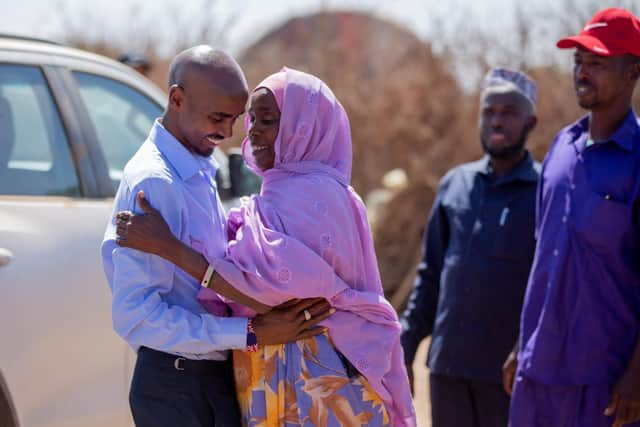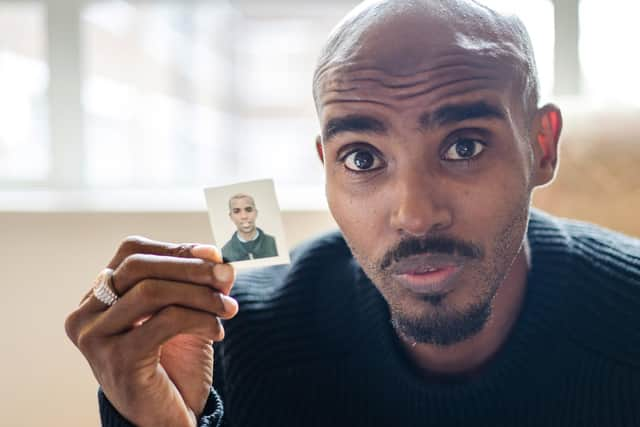Dani Garavelli: All trafficked children deserve help
There was none of that in The Real Mo Farah - not for the viewer, and not for Mo. Born Hussein Abdi Kahin, he only gained his now-famous name when he was trafficked into domestic servitude using another child’s identity at the age of nine. Yet, when he finally connected with that child - now grown-up and living in Turkey - they talked not about the trafficking or its ramifications, but about their common love of Arsenal. By the close, our Olympic hero seemed less like a man in the process of finding himself, than a man in the process of being dismantled.
It was a brave decision to go public. Unlike most victims of trafficking, Farah had gone on to become one of the most celebrated figures in British sport: a gold medallist; a figure so embraced by the establishment he was knighted.
Advertisement
Hide AdAdvertisement
Hide AdHis back story - a refugee who fled war-torn Somalia to be reunited with his parents - was at the core of his public, and perhaps private, persona. It gave him a neat narrative arc, but it suited the state, too. It was a parable showing how the UK cares for the vulnerable; how, here in Britain, migrants can assimilate and succeed. In shattering the myth, Farah has had to accept his past is an enigma which may never be solved. But he has also forced the public to confront much darker realities about the scale and nature of child trafficking.


The programme never got to the bottom of who arranged Farah's trip from Djibouti (where he was living with his uncle after the death of his father). Or why he was taken to the UK while his twin brother was left behind. The woman who brought him here - and in whose home he was forced to work - remained a shadowy figure.
For those predisposed to suspicion, such “gaps” undermined his credibility. Others questioned why he waited so long to set the record straight. But to me, the sketchiness rang truer than pat explanations. And it isn’t hard to understand why someone with a precarious immigration status would keep schtum about anything that might pose a threat
The doubters brought to mind accounts I’ve heard directly from asylum seekers. How they are harangued for documents they don’t possess and evidence they could not have gathered. How they are forced to tell their stories again and again to officials primed for discrepancies. Yet the journeys they have made are chaotic and traumatising, blurring memories and making a linear chronology nigh-on impossible.
The documentary was also a grim testament to the way trafficked children’s futures so often hang on a quirk of fate, on crossing paths with kind and committed individuals.


Before it became obvious he could run, Farah was known chiefly for his behavioural difficulties. Only after his PE teacher Alan Watkinson took an interest in him did a social worker intervene and a friend’s mother agree to look after him. Later, Watkinson helped Farah apply for citizenship, under the name he knew to be false. That citizenship was given, few questions asked. Farah wasn’t just any immigrant/asylum seeker: he was an elite athlete who was going for gold.
Atkinson was a Godsend, willing, not only to support Farah, but to keep his secret from the press. Still, the fate of trafficked children should not hang on one person. There should be systems in place to identify and support all victims, regardless of background or sporting prowess.
Child trafficking is on the rise in the UK. Last year, 5,468 potential victims were identified - the highest ever number and an increase of 10% on 2020. ECPAT - a network of organisations working to end the sexual exploitation and abuse of children - has said the increase “raises concerns about the ability of UK authorities to appropriately respond to these children in light of unnecessary delays to decision-making in their cases, funding constraints for local authorities and lack of specialist support for child victims”.
Advertisement
Hide AdAdvertisement
Hide AdThe Nationality and Borders Act is only going to make matters worse. Having pledged to take the UK out of the European Convention on Human Rights, Attorney General Suella Braverman’s exit from the Tory leadership contest was a small mercy; but there’s plenty to be feared from the other candidates.
Though Farah’s experience was traumatic, he is one of the lucky ones. After the documentary aired, the Home Office issued a statement guaranteeing no action would be taken.
But only two percent of trafficked children are granted leave to remain. Compare Farah’s fate to that of Samet, trafficked to Belgium, then smuggled into Britain at 15. He was placed in foster care, but once he turned 18, his asylum claim was refused. He is now in limbo.
Samet’s situation was highlighted by The Guardian which said his older foster brother Ali *had* been granted leave to remain after he was endorsed by a Michelin-starred chef. Like Farah, Ali was deemed worthy.
Who knows what would have happened to Farah if he’d been less fleet of foot. Perhaps he’d have been left languishing like Samet. The documentary may not have answered all our questions. But it has, at least, started a conversation about the plight of trafficked children, and exposed a double standard in the way they are treated.
ends
Comments
Want to join the conversation? Please or to comment on this article.